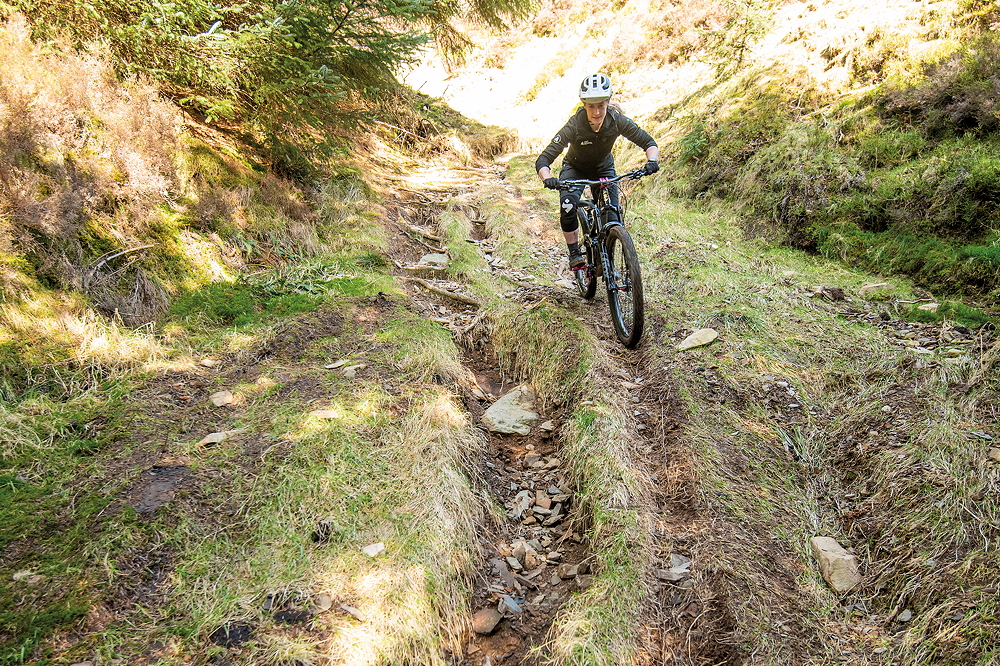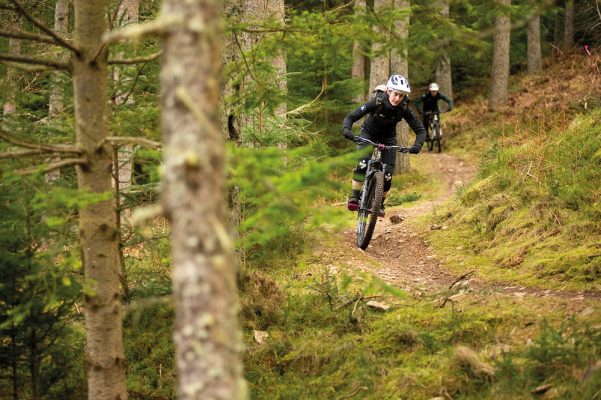Get some goals!
Hopefully you’ve been out a few times since restrictions lifted and you’re starting to get a feel for riding your bike again. With summer just round the corner and dry trails on the horizon again, make the best possible use of your time by setting some deliberate goals and making good progress. That way you can be back to your best, or perhaps even better, for the remainder of the year.
Read more: Best mountain bike routes – 21 great rides in the UK

Taking some time to session a feature or section of track will mean that you can focus on purposeful practice and maximise your time on the bike by making quicker progress
Session something
One of the best things you can do if you want to improve your technique, is to ‘session’ sections of trail. This is when you break down a challenging feature or series of turns into its key elements so you can get a feel for riding it with more control or confidence. Contrary to popular mountain bike culture, you don’t really make that much progress by chasing your pals down trails. This is because you end up just following them into a lot of the same mistakes that they are making. Instead, stop on something that challenges you. Decide what you want to work on, and try the same feature or section a few times before moving on. That way you can get more of a feel for it through repetition and feel better about yourself before you move on. Just because you messed it up first go, doesn’t mean you have to leave it like that.

Expand your horizons and see more of your local hills
Take on a bigger challenge
What’s the furthest you’ve ever ridden in a day? How much climbing do you think you could do in a single ride? Have you ever spent the night in a bivvy bag? As you spend more time on your bike, set yourself a couple of silly goals. They don’t have to be massive. They just have to be able to give you the satisfaction of doing something new. Waking up on the side of a mountain and riding down to the local town for breakfast might be the best thing to happen to you since you discovered Maniac on Netflix during lockdown.

Keep eating and you can go all day
Food is fuel
As the weather improves and you start to feel good on your bike again, you might find yourself tackling more distance, or climbing a bit more than you’ve done before. A huge contributing factor to handling this extra load will be how you fuel yourself. There is loads of information out there that can help, but in a nutshell you need to eat and drink more than you think. A good rule of thumb is to eat something every hour and stay hydrated. Drink at least 500-750ml an hour and don’t get too bogged down with energy products. If you’re drinking an energy mix, smashing gels, and eating stodgy bars, then you will likely become dehydrated because you are having to use all the fluids in your system to process all that dense food. Instead, just keep it simple. Drinking water and eating normal food is perfectly adequate if you mix it up with the odd energy bar here and there.

Changing your pace depending on what terrain you’re riding is a great way of saving energy
Pacing zones
Have you ever thought about where you go hard and where you back off while riding? Trails are a mix of technical bits, smooth-flowing and pedally sections. Using pacing zones can help you get the most out of a trail by being efficient with carrying speed and able to enjoy the whole of the descent. A good way to look at it is by splitting these sections into a traffic light system – red, amber and green.
Red sections would be when things get more technical, this is where we would back off to keep things smoother and in control. These sections are where you wouldn’t normally gain time, there is usually a maximum speed at which these can be ridden and there is a higher risk versus reward. By easing off here, we save our legs for the pedally bits and the climbs. These would be the green sections where we need more power to maintain speed, climb and we can give it everything. The amber sections are in between – here you can pump the bike and work the trail to carry speed. By splitting up a trail in this way, we can clean the technical sections without costly mistakes and still have energy to pedal when we need it.

Spending a few minutes stretching your tired old body may save you from injury further down the road
Stretching
A great way of staying on top of things when you’re taking on more training load is to stretch. It prepares your muscles for a workout, draws your attention to any niggles that might be a problem if you are pushing hard and unaware of their existence, and reduces the likelihood of injury by loosening everything up. We all have our favourites, but take a few minutes before you exercise, or after you’ve done a gentle warm-up, to ease your body into the activity. Even spending 10 minutes at the end of the day stretching will help prevent injury and keep your body working like clockwork for longer. Remember, a grandfather clock is still a clock.
Recovery
After a big day on the bike it’s important that you refuel properly. Eating a balanced and healthy diet is crucial to you feeling good about yourself and allowing your body to recover properly. The old saying “you are what you eat” is so true here. Six beers and a pizza might be tempting when you’re hungry and tired, but lean meat, some good healthy vegetables, good quality bread and fruit for dessert will give your body all the things it needs to rebuild itself stronger.

Technical riding
Perhaps one of your challenges this year will be to finally face a trail that’s been on your to-do list for a while. Give yourself a good run at it by doing some research first. Trailforks is a great place to start – it breaks down the track into distance, descent, and technicality. You might get a description with details on the ‘crux’ of the track. If it’s popular enough there might even be POV footage on YouTube. Whatever you can do to learn about its most demanding sections will help you know what you have to prepare for. The next step will be to try and replicate some of those challenges on less stressful trails. Don’t focus on riding them faster, instead concentrate on doing them smoother. You want to prepare yourself to be able to face your challenge and feel confident that you can achieve your goal when you feel ready.
Checklist
When it comes to technical riding, the secret is feeling confident because you have control. Don’t try and go fast, instead back off and look for ways of smoothing out the trail. Be aware of the lines that you are taking and your body position – especially when things get steep or challenging.
Body position
You are far more likely to move away from the danger than towards it, so if you feel your weight going back, or your arms going straight, then be aware that it’s happening. Moving your body closer to your bike will give you a huge range of motion and mean you can stay neutral when the trail becomes unpredictable. Decide what you want to focus on before you drop into a technical trail and stay on top of it the whole way down.

The next time you feel like you could do a section of trail better, get off and try it again
Line choice
Stopping to look at a tricky section often gives you a much better idea of the amount of choice available on the trail. You can easily miss different line options by riding right past them. Sessioning a small section of trail or a particular corner is useful and a fun way of working out which lines work and which feel best for you. You might find the shortest lines are not always the fastest. Instead, look at opening the trail up, especially when cornering, choosing the wide lines to be able to carry speed out and down the trail. If you stop at a technical section you can suss out the line choice options – which would smooth the trail out for you or link one feature to the next? Push back up beside the trail and have another go. See this is as an opportunity to challenge yourself. Have a look at the more difficult lines to try out by having a few runs at them. This is where sessioning pays off – it’s fun and you can also watch your mates try out different lines and work out which feel and look best.

Look for the grippy bits of a trail and you won’t even notice the roots any more
Grip points
A great way of staying positive on challenging terrain is to actively seek out the grip. Focus on the grip points as you descend and you will almost forget about the slippy or looser features. Remember to stay close to your bike so you have the room to be able to deliver a push with your legs against the parts of the trail you can trust. By deliberately seeking out grip you’ll forget about the tricky bits and your whole perception of the trail will change.




